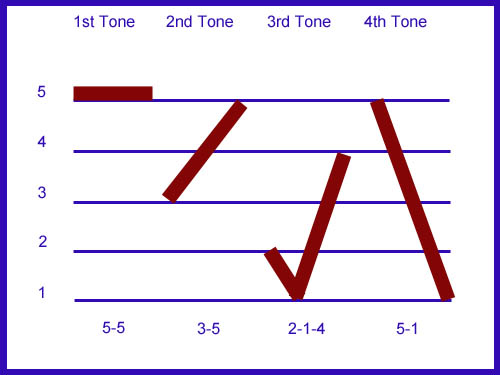Cyphernaut - Tones (Chinese-中文)
One of the things that makes Mandarin Chinese a difficult language for westerners to learn is that it is a tonal language. Tones are important in Chinese and are indicated in Pinyin with tone marks above the main vowel in a Chinese syllable. The same syllable with different tones indicates different meanings.
There are four tones; five if you count the neutral tone (a syllable without tone marks in Pinyin). There is no definite pitch for these tones; they are relative to each individual speaker. The tones are listed here and depicted graphically below.
- 1st tone - a continuous high level tone with a pitch value of 5-5
- 2nd tone - a rising tone that goes from a pitch of 3 to one of 5; the rise in inflection when saying "What?" gives an approximation to the 2nd tone
- 3rd tone - starts with a falling tone from 2 to 1 but then rises subtly to a pitch level of 4
- 4th tone - a falling tone from 5 to 1
- neutral tone - pronunced briefly with tone determined by the preceding stressed syllable i.e. following a first tone, the neutral syllable would have a second tone; following a second tone, it would have a third tone etc.

When vowels appear together in combinations, the tone mark will appear on the main vowel which is determined with the following hierarchical order: a-o-e-i-u-ü. For example, xiē and háo. One exception is when i and u are together, the tone mark always appears on the second vowel, i.e. liù and huì.
The tables below show a few examples of different Chinese or Hanzi characters and how a change in tone changes the meaning of the word or syllable. The Hanzi displayed is Simplified Mandarin.
| Chinese Tones - ba | |||
|---|---|---|---|
| Tone | Hanzi | Pinyin | English |
| 1st tone | 八 | bā | eight |
| 2nd tone | 拔 | bá | pull |
| 3rd tone | 把 | bǎ | measure word |
| 4th tone | 爸 | bà | dad |
| neutral tone | 吧 | ba | imperative particle |
| Chinese Tones - jie | |||
|---|---|---|---|
| Tone | Hanzi | Pinyin | English |
| 1st tone | 接 | jiē | meet,connect |
| 2nd tone | 节 | jié | segment,section |
| 3rd tone | 漫 | jiě | loosen,unfasten |
| 4th tone | 借 | jiè | borrow |
| Chinese Tones - ma | |||
|---|---|---|---|
| Tone | Hanzi | Pinyin | English |
| 1st tone | 媽 | mā | mother |
| 2nd tone | 麻 | má | hemp |
| 3rd tone | 马 | mă | horse |
| 4th tone | 罵 | mà | scold |
| neutral tone | 吗 | ma | questioning particle |
| Chinese Tones - shi | |||
|---|---|---|---|
| Tone | Hanzi | Pinyin | English |
| 1st tone | 湿 | shī | wet,damp |
| 2nd tone | 十 | shí | ten |
| 3rd tone | 使 | shǐ | make |
| 4th tone | 是 | shì | be |
| Chinese Tones - wu | |||
|---|---|---|---|
| Tone | Hanzi | Pinyin | English |
| 1st tone | 屋 | wū | house,room |
| 2nd tone | 无 | wú | nothing;have not |
| 3rd tone | 五 | wǔ | five |
| 4th tone | 物 | wù | matter |





